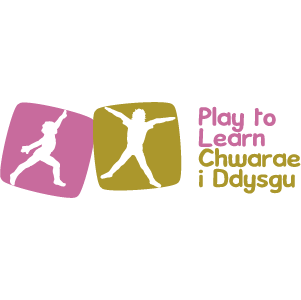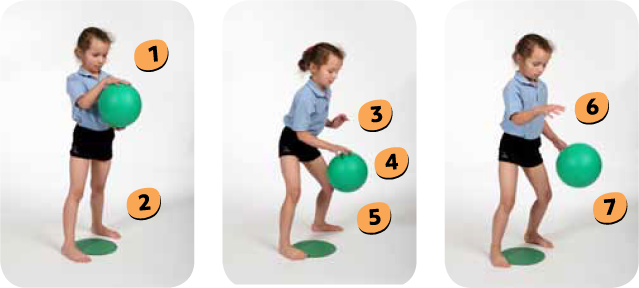
Instructions
Bouncing is pushing the ball towards the ground with sufficient force to allow the ball to bounce back up to hand/hands at a level just below the hip. Bouncing is typically performed in a stationary position. It is important for playground games, basketball, handball and rhythmic gymnastics.
- Start with one hand supporting the ball and the other on top of the ball
- The feet are slightly astride
- Use the fingertips
- The wrist controls the ball
- Push the ball down
- Push the ball slightly forwards
- Keep the ball below your waist

Safety
Ensure…
- children keep their heads up
Opportunity to develop
- Co-ordination
- Control
- Spatial awareness
- Accuracy
- Hand–eye co-ordination
- Body awareness
- Manipulative skills
Physical Development Area of Learning
- contributes to ‘Personal’ and ‘Adventurous and physical play’ skills sections
If you see
| Observation | Likely Cause | Solution |
|---|---|---|
| Unable to maintain control of the ball in one place | Slaps the ball with an open hand with little control | Spread fingers to control the bounce |
| Grips the ball with their hands placed on the side of the ball and palms facing each other | Starts with ball in two hands | Palms of hands should face the floor |
| Ball bounces up too high | Thrusts the ball downward with both arms | Practise with balloons and beach balls initially with less bounce. Progress onto sponge balls. |
| Ball controls the child rather than the child controls the ball | Pushes too hard on the ball | Keep the ball bouncing within a certain area |
| Ball contacts the surface close to the body | Ball not pushed slightly in front and to the side of the body | Place a hoop or rope in front of the child. Aim to keep the ball at arm’s length. |
| Ball bounces away from the child | Body too upright | Encourage a slight forward lean over the ball |
Can you see?
- the child’s feet placed one in front of the other?
- the child’s opposite foot to their bouncing hand forward?
- the child showing a slight forward lean?
- the child starting with the ball at waist height?
- the child pushing the ball to the ground with a firm follow through?
- the child remaining in one position whilst bouncing?
- the child keeping the ball close to their body whilst bouncing?
- the child pushing the ball to the floor with their fingers?
-
Mostly No
- Practise the action without a ball.
- Hold the ball at arm’s length and try to drop the ball in a hoop. Count how many times the ball bounces before stopping still. Repeat using different sized balls / different textured balls.
- Hold a balloon. Push the balloon to the floor. Try to get it to bounce. Stop the balloon from going up in the air.
- Using a large fit-ball / Swiss ball, press down to make the ball bounce.
- Drop a ball or beach ball with two hands. Drop the ball so it bounces up. Touch the ball with one hand or two hands.
-
Yes and No
- Bounce and catch the ball in a circle, hoop, chalk markings. Keep the ball in the circle. Try various patterns, two bounces and catch.
- Bounce five times and catch.
- Bounce the ball on the spot.
-
Mostly Yes
- Bounce the ball at different levels: knee, waist
- Bounce the ball close to them, far away, to the side, in front
- Bounce the ball around the body passing from one hand to the other
- Bounce different types and sizes of balls
- How many bounces can the child do in a row?
-
Challenge
- Bounce a ball around the body whilst standing on a line, a beam or a wobble spot
- Bounce a ball dropped by your partner to keep the ball under control
- Bounce a ball at different heights without losing control
- Bounce the ball in response to a range of cues
- Combine dribbling with hands, bouncing, catching, throwing and fast feet in response to a range of cues, using different directions, pathways and speeds


